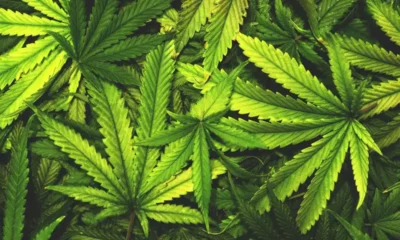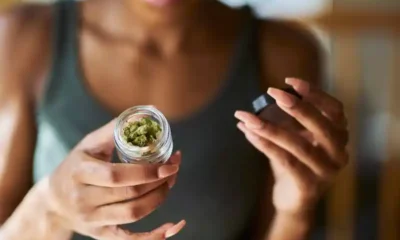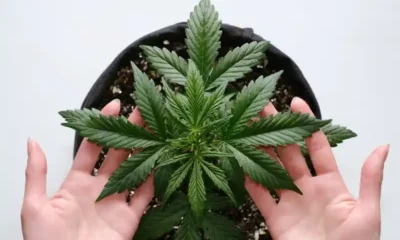Connect with us
Published
4 weeks agoon

In this new era for cannabis in the West, with more than half of the U.S. population living in states with both legal recreational and medical cannabis, the young people that have largely grown up in this shifting landscape have clearly taken a liking to the substance.
Abundant research has shown that cannabis is more popular than ever among young adults, and when it comes to one of the first states to usher in adult-use reform measures, that trend stays constant.
The results of the latest Young Adult Health Survey, conducted by researchers through the University of Washington, were shared with members of the Washington State Liquor and Cannabis Board earlier this week, finding that daily cannabis consumption has never been higher among young adults—specifically those aged 18 to 25.
The most recent anonymous survey of 1,237 young adults was completed in late 2023 and marks its 10th year, with the first survey occurring in 2014 right before Washington’s first recreational cannabis stores first opened their doors.
The survey asks questions about cannabis use, which is largely the main focus of the dataset, though it also addresses the use of other substances like alcohol, synthetic cannabis, nicotine, heroin, kratom, hallucinogens (at full dose and microdose), recreational use of pain relievers, fentanyl and methamphetamines.
For the entire cohort, the number of young adults consuming cannabis on a daily basis is “higher than ever” at 10.4%, UW researcher Dr. Jason Kilmer told the board members. For those between 21 and 25, the number rises to 14% daily use. Of those surveyed, 25% of adults aged 21 to 25 use cannabis at least once weekly, or more than 14% for those between 18 and 20.
Conversely, nearly 54% disclosed that they never use cannabis.
In Washington, and all states with legal adult-use cannabis, consumers must be over the age of 21 to buy. Some of those respondents aged 18 to 20 get it from their parents with permission, 15.77% in 2023 compared to 5.7% of those in 2014 who reported the same — a three-fold increase. The majority, 58%, of respondents between 18 and 20 said they got cannabis from friends, while 33.36% said they gave money to someone to buy it for them.
The survey examines these trends over the past decade, with “at least weekly” cannabis use among the entire cohort showing an upward trajectory, while daily use has fluctuated for the 18 to 20 group but appears to be increasing for the 21 to 25 group.
That said, the survey also shows that young adults in Washington appear to be increasingly more responsible over time when it comes to getting behind the wheel while high. It asked how many times respondents drove a car or other vehicle within three hours of using cannabis. In 2014, 50.59% said they “never” did, and that number has steadily grown to 68.69% in 2023.
Consequently, the other responses (1 time, 2-3 times, 4-5 times and 6 or more times) steadily fell over the past decade.
When it comes to other substances, the survey found a “significant decreasing trend” in alcohol use, both in the last year and month; cigarette use in the last year; recreational pain reliever use in the past year and heroin use in the past year.
While cannabis use is on the rise, the yearly-use numbers indicate that alcohol is still by far the most popular among the respondents. While recreational cannabis was used in the past year by 36.57% of those 18 to 20 and 51.9% of those 21 to 25, alcohol was used by 57.39% and 86.81% of those respective groups.
In reference to the daily use increase, Kilmer said that “endorsing symptoms associated with cannabis use disorder have gone up, so certainly as use goes up, risk for things like cannabis use disorder go up as well.”
The findings echo another recent study, albeit with a broader focus, which found that daily or near-daily cannabis users outnumbered daily or near-daily drinkers for the first time in 2022 when the data was last collected. This study similarly noted that alcohol is still the more commonly used substance, though cannabis users tend to consume more often than alcohol users.
The study notes that the median drinker reported alcohol use on four to five days in the past month, versus 15 to 16 days of past-month use for cannabis users. Past-month cannabis consumers were almost four times as likely to report daily or near-daily use and 7.4 times more likely to report daily use, according to the study.


Massachusetts Lawmakers Push Intoxicating Hemp Regs to 2025


Arizona’s Social Equity Program Isn’t Living Up to the Hype


UC Berkeley To Enlist Human Subjects in Groundbreaking Psilocybin Study


Kamala Kush Strain Sparks Conversation on Jimmy Kimmel Live


Psilocybin Therapy Pilot Program Bill Introduced in California


New York Cannabis Agency Announces Cultivation Rules, License Updates
